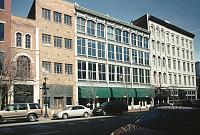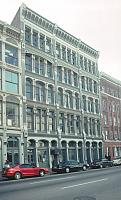| In the second half of the 19th century buildings with cast iron, pre-fabricated units attached to the frame began to replace masonry buildings, especially for inexpensive commercial use. In the United States James Bogardus is credited with the development of these cast iron units, generally imitating classical architecture, which could be assembled in repeated bays. Since cast iron was cheaper than stone or brick and since mass-produced units could be assembled quickly, in some areas whole streets were in fact comprised of cast iron facades, although they resembled elaborate masonry buildings. The Soho district in New York City has some of the most outstanding cast-iron buildings. Cast iron could be painted a variety of colors and because of its strength allowed for a greater span of windows. |

|
Streetscape with cast iron structuresCast iron prefab units were ornamented in a variety of styles--Greek revival, Italian or French Renaissance, Georgian, etc. Foundries in Louisville produced these units so that today Louisville has several city blocks with of cast-iron buildings, beautifully ressored. |
| |
|
Center and right: the Hart Block by Charles D. Meyer, 1884 |

|

|

|


 Click here to return to index of art historical sites.
Click here to return to index of art historical sites.
 Click here to return to index of artists and architects.
Click here to return to index of artists and architects.
 Click here to return to chronological index.
Click here to return to chronological index.
 Click here to see the home page of Bluffton College.
Click here to see the home page of Bluffton College.
